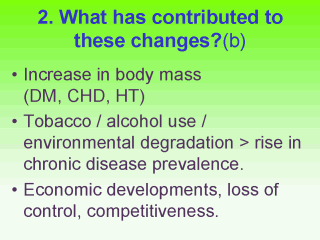 |
Inactivity and greater access to nutrition leads to
increase body mass. This is made worse by communities which have adapted genetically to
low calorific diets suddenly (in evolutionary terms) having unlimited access to
calorie-dense diets. Other profit driven products (including processed, “value-added”
- read more expensive- foods; tobacco and alcohol) are marketed aggressively, and
environmental degradation from unrestrained population pressure on limited resources are
contributing to rising disease prevalence. Economic growth, driving increased
competitiveness, greater pressure on the workforce, less control over work, chronic
unemployment and more work insecurity contribute to significant adaptive demand on people,
leading to more extreme forms of “relaxation” such as substance abuse, and breakdown
of traditional support systems such as the family and community. The nutritional
environment prevailing in the uterine environment during gestation seems to “set” the
body’s metabolic tone. Variation throughout the life-span from this nutritional standard
is associated with greater risk of a range of chronic diseases, including CHD, diabetes
and other currently-important chronic diseases. This is called “Barker’s
Hypothesis”. So mothers who had lo, but adequate, nourishment during their pregnancies,
and who give birth to low weight babies, which are then subject to a richer nutritional
environment, showing increased weight gain and higher BMI as children and adults are at
greater risk of many diseases, than either low birth weight babies that retain low BMI
throughout life, or high b.w. babies that retain high b.w. |
